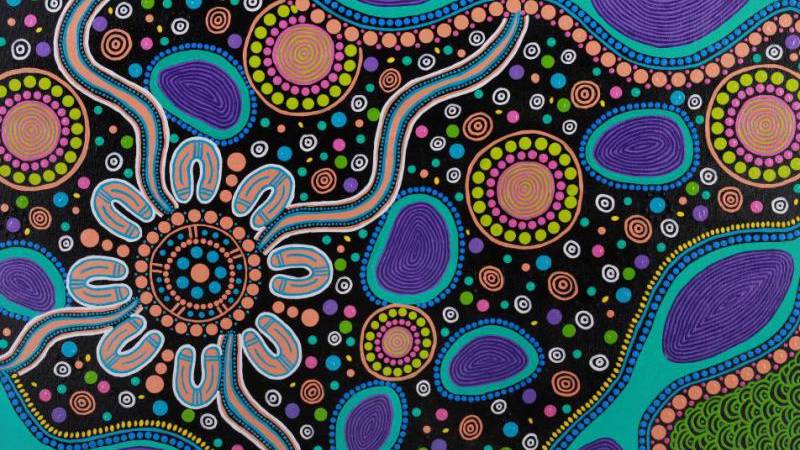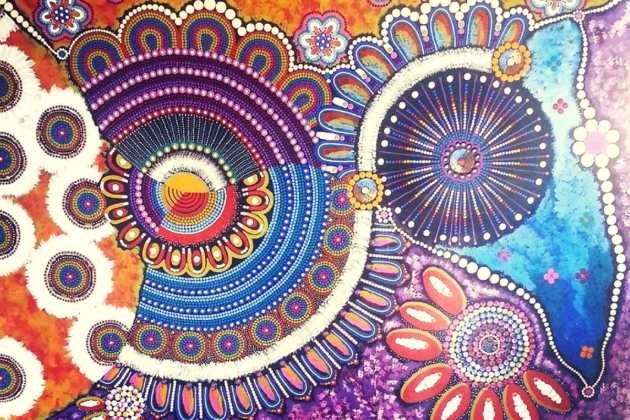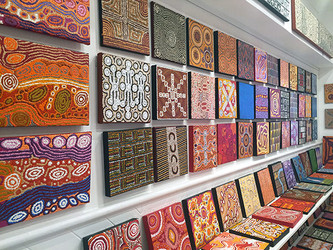What is the Meaning Behind Aboriginal Dot Painting?
Posted by Evia Norwood on 29th Aug 2021
Why do Aboriginal people do dot paintings? Aboriginal art is famous for dots. See great examples of dot paintings and discover the reason behind it.
Unarguably one of the most recognised forms of Australian art, Aboriginal dot paintings are highly valued worldwide as being a unique and integral part of Australian Indigenous culture. The story behind the meaning behind these dot paintings is both interesting and captivating, with several theories as to how they came about. One thing that is certain is that these works are influenced by sacred rituals and secret practices that reflect the earliest period of this ancient culture.
Aboriginal dot paintings have both an artistic and anthropological significance, and nowadays are an important form of expression as well as a substantial way of income for many remote Indigenous communities. These pieces are extremely sought after around the globe. Just this past June, a collection was auctioned in London for over $2 million.
But what is it that makes these paintings so important to Indigenous culture? What messages do the symbols and diagrams of these images represent?
The Australian Aboriginal culture is about 60-80,000 years old, making it the longest surviving culture in human history and the longest running art culture. We know this information thanks to rock art, which shows evidence of Aboriginal culture dating back over 30,000 years. Historically, ochres were used to paint on the rocks.
Because Aboriginal culture does not have a written language, drawings were crucial as they were used to tell stories and pass on deep knowledge and history through the generations. The spiritual and cultural beliefs of the Aboriginal people, as well as their profound experience of the land and survival skills, were portrayed by symbols and icons through drawings on rock, sand, or the body.

Artwork by Alison Simpson
These drawings had different interpretations depending on who would read them. If told to children the drawings would have a simple message of morals, teaching the young the difference between right and wrong. For the elders, however, the message was more profound.
Although Indigenous people used art as a form of communication and ceremony, passing on information through drawings on rocks and bodies, their first watercolour paintings did not occur until 1930, and it wasn’t until about 40 years ago that Indigenous Australians started painting their stories on canvas.
Use Of Canvas And Origins Of The Dot Painting Technique
The first Aboriginal works of art made on canvas and the start of the central desert art movement traces back to 1971 in Papunya, an artificial community of 2,500 Aboriginal people who had been assimilated from the desert near Alice Springs.
There, a teacher named Geoffrey Bardon encouraged Aboriginal men to draw and paint their dreamings on something more permanent than sand or bodies during ceremony. After some drawings on paper, the artists painted a school wall. The resulting mural generated interest in the community, and soon after, many of these men started painting on cardboard and pieces of wood, which would later be replaced by canvas.
The artists’ reputations began to grow, and as their paintings started to spread around Australia, they began to feel more self-conscious about what was being depicted in their art. Some of the artists’ secrets and sacred beliefs were in those paintings, and were not intended to be seen by white men, children, and women or other Indigenous clans. This is where theories about the dot painting technique emerge. Although there is no definitive answer as to why the technique originated, it’s likely that it is a combination of theories all play an important part.

Artwork by Tradara Briscoe
When Indigenous artists realised that they had little control over who could see their paintings, they began to worry that non-initiates or westerners may be able to understand their meaning. To keep this from happening, they started using heavy layering and overdotting their paintings as a way to hide and protect their sacred elements in the works that held special internal cultural value. This is one of the prime theories as to how the dot technique began.
It is now known, however, that westerners could never have learned the art’s meaning regardless, as they were not familiar with the iconography used by Indigenous people. This fact has made the practice of overdotting the paintings more of a design or artistic element in modern day Aboriginal artworks.
A second theory of the dot technique’s origin suggests that the Central Desert people’s sand drawings originally consisted of a series of lines, and that this dotting style was merely translated from sand onto the canvas.
A third theory relates to how the mapping of the land was represented by the Indigenous culture. When flying over land, looking down in a bird’s eye view, the landscape is dotted with ‘dots’ of bushes, trees, flowers, and rocks. Because Aboriginals had a deep knowledge of the land they had been walking for generations, it is believed that they were simply representing these ‘landscape dots’ of the land by painting them onto the canvas.
Dot Painting Features

Art by Shaneiva Chatfield
Like any successful art form, the dot painting technique inspired other Indigenous people to develop their own unique styles. This led to the development of various dot painting techniques that differed depending on the region the artist was from, the language they spoke, and the community they belonged to.
Even within the same region, however, there can be differences in the way the paintings are created. Some artists choose to overlap dots, while others choose to connect them or enclose them with larger dots. Some merge the dots into lines, or draw dots so tiny that they appear to be a line. The patterns can be neat and traditional or wild and dramatic. It doesn’t matter how the dots are represented on the painting really, as long as they are recognisable.
The materials usually used in Aboriginal dot paintings are ochre and acrylic paints, with the latter being more popular amongst modern artworks. The paint can be either textured or flat.
The colours used can also represent certain communities. In the Kimberley region, for example, materials were obtained from the land, and so you’d see a lot of use of ochre, iron clay pigments, charcoal, and bush leaves. These elements served to create colours like white, yellow, red, black, and green. In the Papunya Tula community, they prefer soft earthy colours and orange tones. Western Desert communities tend toward an emphasis on primary colours. Paintings with bright and modern colours can also be found with modern materials creating contemporary interpretations of ancient cultural stories. It is generally accepted that with the female painters arriving on the scene, livelier colours were used in these spectacular paintings. Today, the vast majority of successful Aboriginal artists are women.
Source: www.wentworthgalleries.com.au

